
|
Flying on Nuclear, The American Effort to Built a Nuclear Powered Bomber by Raul Colon |
||
|---|---|---|---|
| Home Page | Articles Index | ||
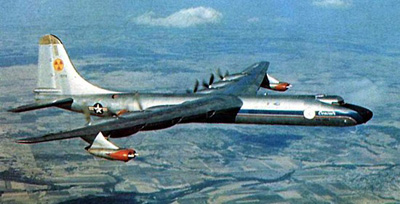
|
The NB-36H was a modified Convair B-36 Peacekeeper that was used as a testbed for an American nuclear powered bomber. | ||
| Fascination about a potential nuclear power that might offer limitless energy led the United States Air Forces commenced in 1944 as an experimental program, designed to produce an operational nuclear powered bomber. The idea of nuclear propulsion energy to power an aircraft dates back to 1942 when Enrico Fermi, one of the fathers of the atomic bomb, discussed the idea with members of the Manhattan Project. For the first two years, engineers were immersed on the issue of how radiation would affect the performance of a flying platform, its avionics, materials, and more importantly, its crew. The program seemed lost in endless detailed fights and controversies, when in 1947, it received new life. The newly formed U.S. Air Forces decided to invest the necessary resources to make the program feasible. Allocation for ten million dollars was promptly made available to the program. From early 1948 to 1951, extensive research was made in reactor technologies and engine transfer systems; the backbone of the nuclear powered aircraft. Many configurations were proposed, Dual reactor, combination (chemical and nuclear) and single systems were tested. Eventually it was decided that a single reactor would provide the aircraft with the necessary flight reliability. Next came the debate about what type of transfer mechanism would be implemented. Transferring nuclear power to a conventional engine had long been seen by engineers as the main obstacle in the development of the program. | |
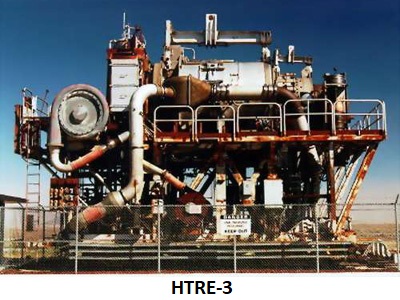 |
In 1949, the program ran a series of tests, known as the Heat Transfer Reactor Experiment (HTRE), involving three types of reactors, with the purpose of determining the most efficient method of transferring energy from the reactor. After an extensive trial series, the HTRE-3 emerged as the selected transfer system. The HTRE-3 was a Direct-Cycle Configuration. In a direct cycle system, the air entered the engine through the compressor of the turbojet, it then moved to a plenum intake that directs the air to the core of the reactor. |
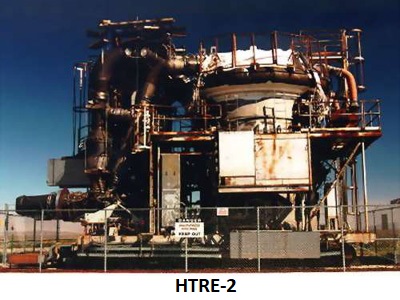 |
At this point the air, serving as the reactor coolant, is super-heated as it travels through the core. After that stage, it goes to another plenum intake; from there the air is directed to the turbine section of the engine and eventually to the tailpipe. This configuration allowed the aircraft engine to start on chemical power and then switch to nuclear heat as soon as the core reached optimized operational temperatures, thus providing the proposed aircraft the ability to take-off and land on conventional power. |
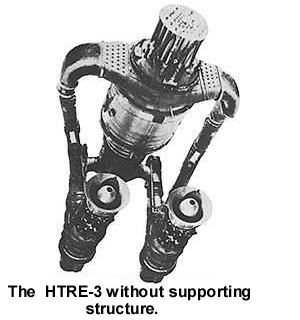 |
Another system considered was the Indirect-Cycle Configuration. In this configuration, the air did not go through the reactor core, air instead passed through a heat exchanger. The heat generated by the reactor is carried by liquid metal or highly pressurized water, to the heat exchanger where the air is, thus heating the air in its way to the turbine. Engineers preferred the direct-cycle approach due to the fact that was simpler to produce; program managers preferred the idea because its development time was relatively short compared to the indirect system. |
| After establishing the parameters for the power plant and the transfer mechanism, engineers commenced work on the shielding for the crew and aircraft avionic systems. Initial plans called for the shielding of the reactor by massive layers of cadmium, paraffin wax, beryllium oxide, and steel. The idea behind this setting was that the more protection the reactor have, the less shielding the crew cabin would require. Technically, this was a sound approach, but in a rapidly functioning environment such as an aircraft setting, this shielding proved to be ineffective. For this reason it was decided to implement what is known as Shadow Shielding Concept. In shadow shielding, the layers of protection would be equally divided between the reactor and the crew cabin. Shadow Shielding would also provide a more robust protection for the aircraft’s avionics systems. An added plus from the implementation of this system was the reduction in the weight of the aircraft due to the distribution of the shield. | |
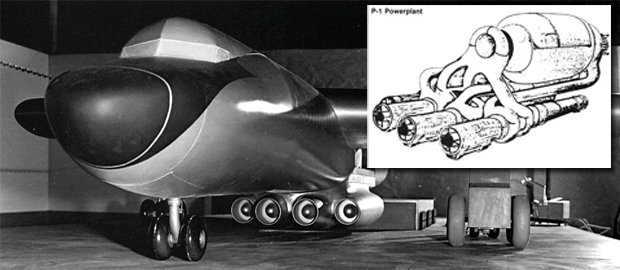
| |
| Having tackled the reactor, transfer mechanism, and shielding problems, the program moved it to the aircraft design stage. By late 1951, the program was heavily involved in the acquisition of a test-bed type aircraft for the initial trials of the configuration. The only proven airframe large enough to carry the massive reactor and Heat Transfer system was the Convair’s B-36 Peacekeeper Bomber. The Peacemaker started to enter front line service with the U.S. Air Force in late 1948 and at the time of the nuclear powered program, was the Strategic Air Command (SAC) main nuclear deterrent platform. The B-36 was indeed massive. The dimensions are impressive even today. A wingspan of 230 ft, a length of 162 ft 1in, high of 46 ft 8in, and a wind area of 4,772sq ft. This bomber maximum take-off weight was an amazing 410,000 lbs—which is why the program managers selected the B-36. A service ceiling of 39,900 ft and a climb rate of 2,220 ft per minute were also pluses in the selection process. Once the testing aircraft had been identified, the next phase would commence at once—the conversion of the B-36 into an experimental aircraft. The main modification made to the original B-36 airframe was on the nose cone section. The original crew and avionics cabin was replaced by a massive 11 ton structure lined with lead, and rubber. Water tanks were also placed in the aft section of the frame to absorb any escaping radiation. | |
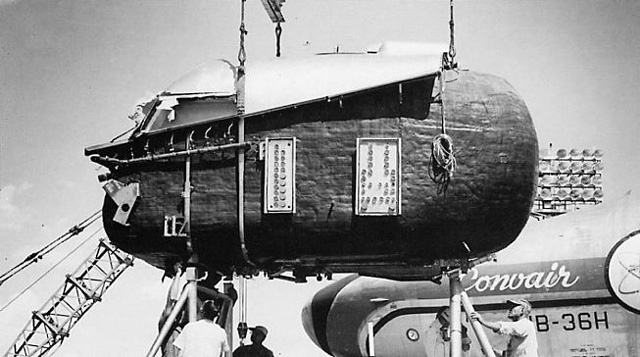
| |
| A special shielded cockpit was installed in the NB-36H | |
|
The other section of the plane that underwent significant modifications was the rear-internal bomb bay. Internal cross sections were removed as well as many of the bomb carrying rafts in order to make space for the nuclear reactor power plant. These alterations made it possible for the aircraft to receive a new designation. It is from this moment on that this sole B-36 Peacemaker, number c/n 51-5712, sample would be called Nuclear Test Aircraft-36. An additional designation change was made when the nuclear powered plant was installed on the aircraft. Thus the NB-36 “Crusader” was born.
Identifying the aircraft was the radioactivity symbol painted on the tailfin. The R-1, one standing for the energy it would generate, a one megawatt; reactor installed on the aircraft was a liquid-sodium cooled power plant winched up into the plane’s bomb bay at a dedicated pit on Convair’s Fort Worth plant every time the NB-36 was scheduled to take to the air. When the NB-36 landed, the R-1 was removed for research purposes. The original B-36 was powered by six Pratt & Whitney 3600 hp, R4360-53 radial piston engines, supplemented by four General Electric 13,500 lb thrust J47-19 turbojets. After conversion, the engines were removed and a new configuration was incorporated. The NB-36 now had four GE J47 nuclear converted piston engines generating 3,800 hp augmented by four 23.13 kn turbojets generating 5,200 lbs of thrust. Each of the engines utilized the Direct-Cycle Configuration for power conversion. The NB-36 was designed from the beginning, to be propelled to the air with a conventional chemical mixture, and then the crew would switch on the reactor after achieving the necessary heat requirements on its core. On landing approaches, the aircraft would switch back to chemical mixture. This procedure was implemented in order to minimize the possibility of a major radiation leak in case of a crash landing. | |
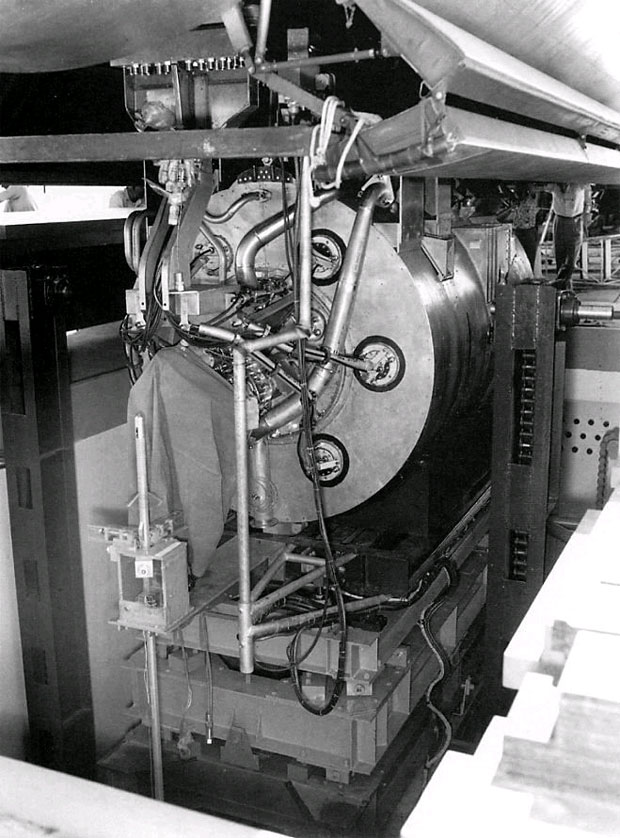
| |
| The Heat Transfer System Being loaded into the bomb-bay of Convair NB-36H. | |
| The NB-36 made 47 recorded flights between the summer of 1955 and the fall of 1957. All these tests were made operating the NB-36 with conventional chemical power. The R-1 reactor was turned-on on many of these flights, not to actually power the aircraft, but to test and collect data on the feasibility of a sustained nuclear reaction on a moving platform. All the data collected by these tests showed the program managers that the possibility of using a nuclear power plant to provide an aircraft with unlimited operational range was indeed at their disposal at this time. Impressive as the taxi and flight testing were for the NB-36, the complete concept of a nuclear powered aircraft was made irrelevant by advances in conventional aircraft and engine design and the public concern about the dangers of flying a nuclear reactor over their homeland. In the end, after expending no less than $469,350,000 on the nuclear powered program and having a concept aircraft flying, the U.S. Air Force shelf the program in the late 1960s, thus ending any major attempt by the United States to utilizing nuclear propulsion to impulse an aircraft in combat.@ | |
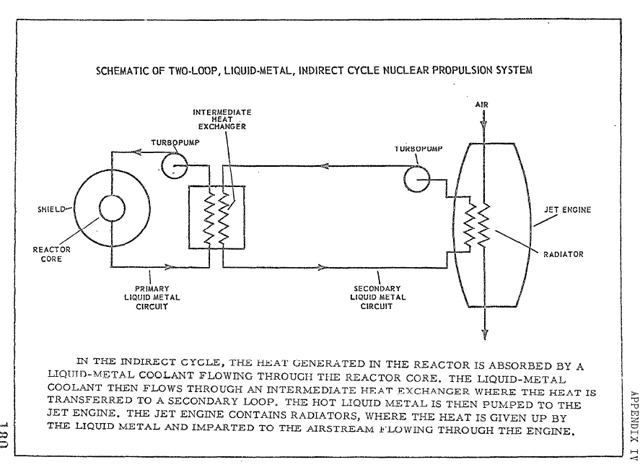
| |
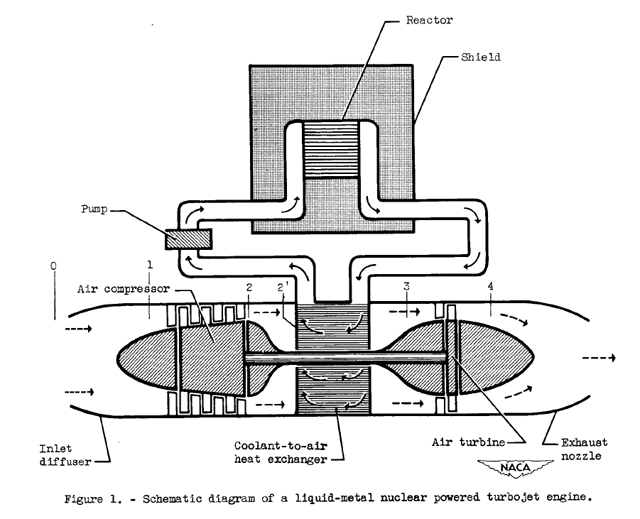
| |
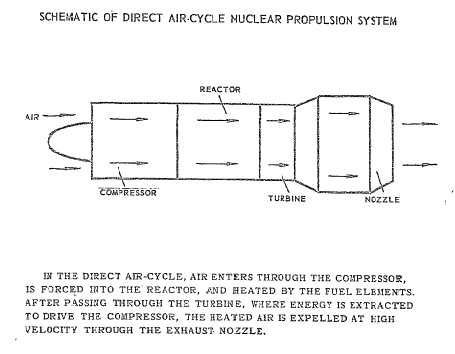
| |
|
The author Paul Colon is a freelance writer who resides in San Juan Puerto Rico. rcolonfrias@yahoo.com | |
Sources
|
1. Concept Aircraft: Prototypes, X-Planes, and Experimental Aircraft; Edit Jim Winchester, Thunder Bay Press – 2005 2. Peacetime Use of Atomic Energy; Martin Mann, The Viking Press – 1961 3. The X Plane; Jay Miller, Aerofax – 1988 4. Aircraft Nuclear Propulsion Program; Metal Progress – 1959 5. The World Encyclopedia of Bombers; Francis Crosby, Anness Publishing - 2004 |
Return To Articles Index.
© The Aviation History On-Line Museum.
All rights reserved. August 6,2007.
Updated November 25, 2019.